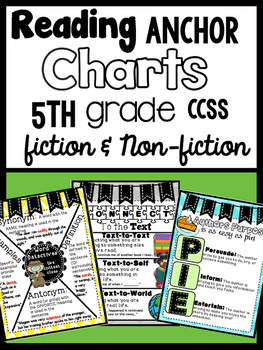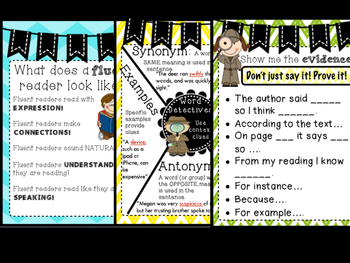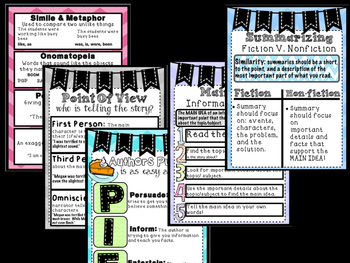5th Grade Reading Anchor Charts (Common Core) Includes Fiction + Nonfiction
The Paisley Owl
3.4k Followers
Grade Levels
4th - 6th
Subjects
Resource Type
Standards
CCSSRL.5.2
CCSSRL.5.3
CCSSRL.5.4
CCSSRL.5.5
CCSSRL.5.6
Formats Included
- PDF
Pages
24 pages
The Paisley Owl
3.4k Followers
What educators are saying
These were great to use for examples and charts the could copy in their notebooks to use as a reference.
Description
All of the reading anchor charts you need for 5th grade! Addresses the fifth grade reading common core standards for both fiction and nonfiction!
1. Fluency
2. Context Clues (word detective)
3. Evidence based statements
4. Inferences
5. Text Connections (text-to-text, text-to-self, text-to-world)
6. Stop & Jot
7. Theme
8. Summarizing a fictional text
9. Character analysis
10. Getting to know fictional characters
11. Compare & Contrast
12. Figurative Language
13. Point of view (fiction)
14. Authors Purpose (PIE)
15. Main Idea: informational text
16. Summarizing: Fiction V. Nonfiction
17. Nonfiction text features
18. Organization of nonfiction texts
19. Informational texts have...
20. Close Reading (individual)
21. Close Reading (class)
Check out the preview for a closer look!
Looking for reading AND writing anchor charts? Click the link below for the reading & writing anchor chart bundle:
Reading & Writing Anchor Chart Bundle
**Questions?? ** e-mail Tptfabulousfifth@gmail.com
******* DON'T FORGET: leave feedback for TPT credits towards future purchases!*****
1. Fluency
2. Context Clues (word detective)
3. Evidence based statements
4. Inferences
5. Text Connections (text-to-text, text-to-self, text-to-world)
6. Stop & Jot
7. Theme
8. Summarizing a fictional text
9. Character analysis
10. Getting to know fictional characters
11. Compare & Contrast
12. Figurative Language
13. Point of view (fiction)
14. Authors Purpose (PIE)
15. Main Idea: informational text
16. Summarizing: Fiction V. Nonfiction
17. Nonfiction text features
18. Organization of nonfiction texts
19. Informational texts have...
20. Close Reading (individual)
21. Close Reading (class)
Check out the preview for a closer look!
Looking for reading AND writing anchor charts? Click the link below for the reading & writing anchor chart bundle:
Reading & Writing Anchor Chart Bundle
**Questions?? ** e-mail Tptfabulousfifth@gmail.com
******* DON'T FORGET: leave feedback for TPT credits towards future purchases!*****
Total Pages
24 pages
Answer Key
N/A
Teaching Duration
N/A
Report this resource to TPT
Reported resources will be reviewed by our team. Report this resource to let us know if this resource violates TPT’s content guidelines.
Standards
to see state-specific standards (only available in the US).
CCSSRL.5.2
Determine a theme of a story, drama, or poem from details in the text, including how characters in a story or drama respond to challenges or how the speaker in a poem reflects upon a topic; summarize the text.
CCSSRL.5.3
Compare and contrast two or more characters, settings, or events in a story or drama, drawing on specific details in the text (e.g., how characters interact).
CCSSRL.5.4
Determine the meaning of words and phrases as they are used in a text, including figurative language such as metaphors and similes.
CCSSRL.5.5
Explain how a series of chapters, scenes, or stanzas fits together to provide the overall structure of a particular story, drama, or poem.
CCSSRL.5.6
Describe how a narrator’s or speaker’s point of view influences how events are described.





